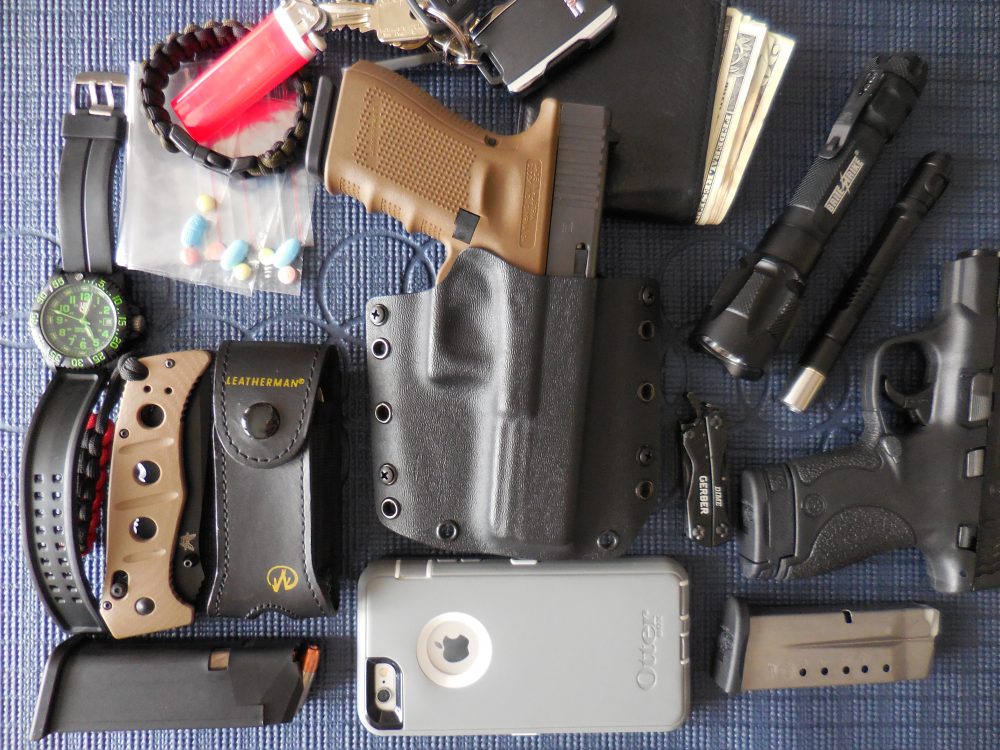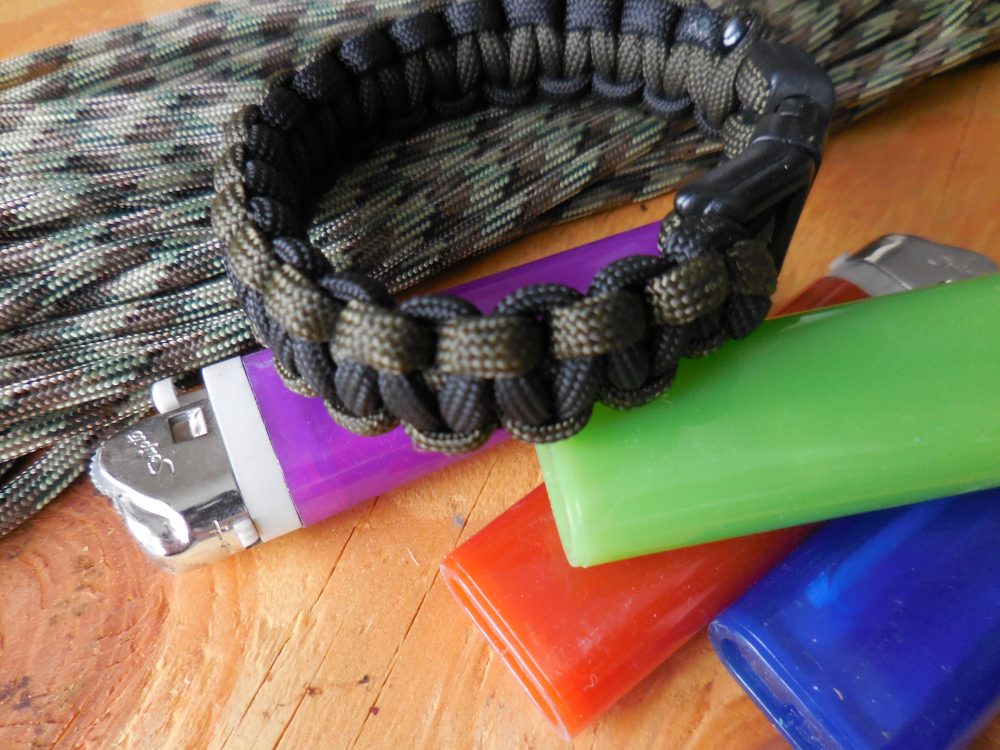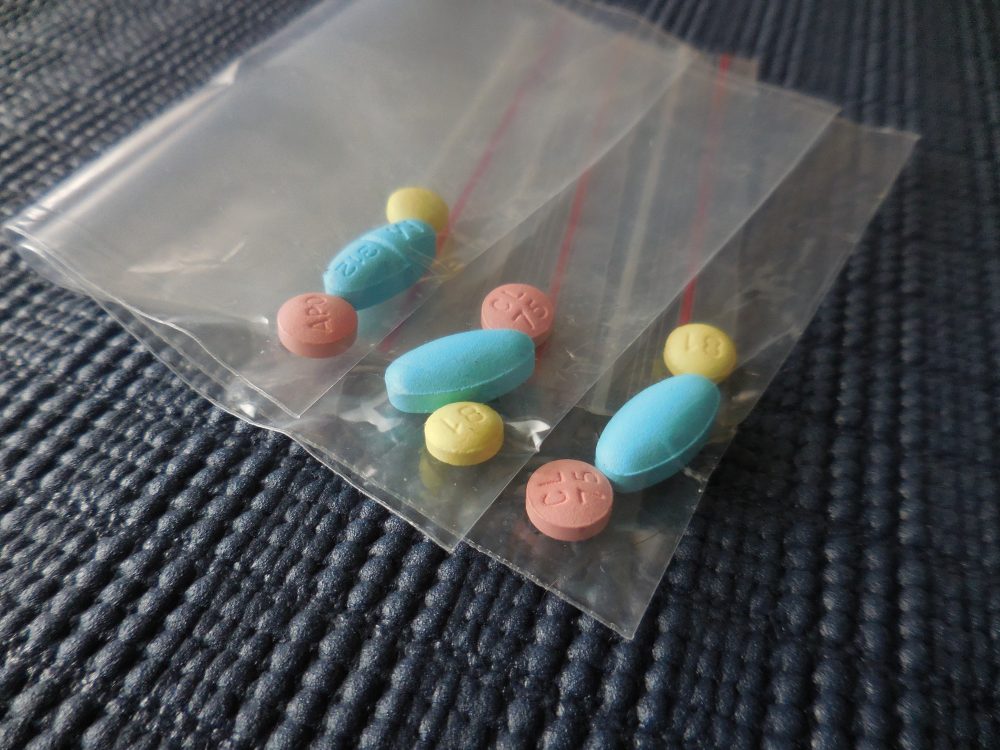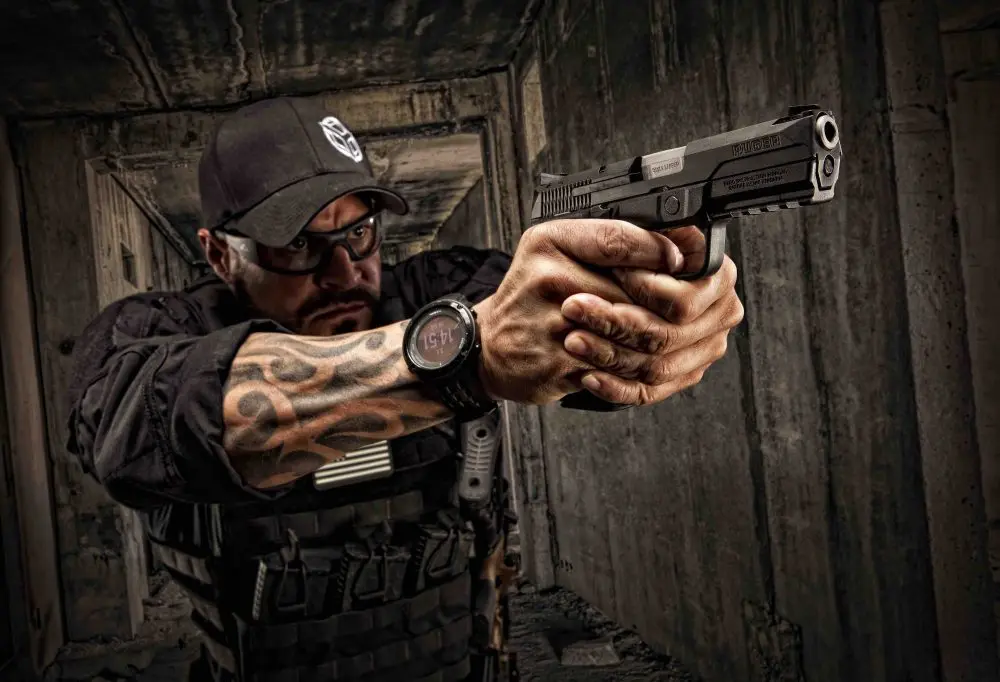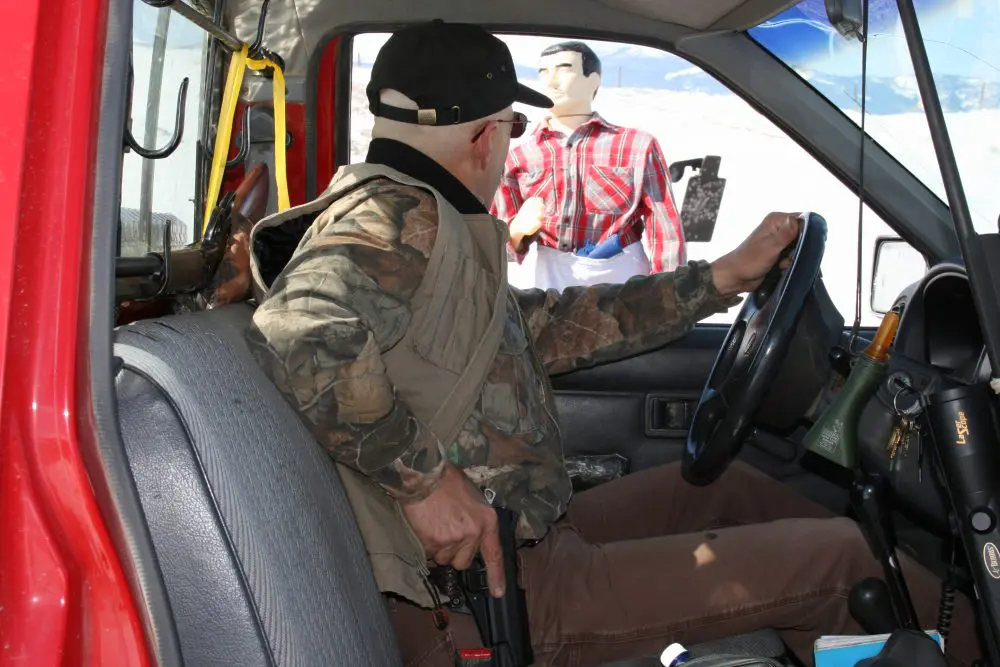Different tools for different situations. Make sure you have a variety of tools in your EDC toolbox.
Everyday carry (EDC) refers to the items, large or small, we carry on a consistent basis. Think of them as your must-have gear to assist in dealing with everyday needs, from the mundane to the extreme. What we carry actually says quite a lot about who we are and how we view the world around us.
Since our individual carrying capacity is always limited by space and weight, the EDC items we choose must be portable, useful (preferably multi-purpose), and practical for the circumstances and our individual needs. While there isn’t an all-in-one solution, finding the right balance is well worth the time and effort. Let’s explore the various ways in which we can use our limited pocket (or bag) space to the fullest advantage, and increase the odds of having what we need when we need it most.
A 550 Para Cord bracelet can hold seven to eight feet of para cord and comes apart easily if well made. Disposable lighters are inexpensive and reliable.
Table of Contents
WHY EDC?
Why do we carry anything at all? If you were to empty your pockets right now, what would you find? A wallet, cell phone, keys, maybe some cash? We carry these items because we need them. It’s difficult to imagine getting on with a typical day without these things.
Do you remember that sick feeling you got in the pit of your stomach the last time you arrived at your destination only to discover you had left your wallet or cell phone at home? It was probably a very challenging day as you struggled to adjust to life without money, plastic, and personal communications.
But while these items may be an integral part of our daily routine, what about when the unexpected occurs? Will those everyday items be enough? Not likely. Part of what it means to be prepared is thinking beyond the daily routine, and planning for those times when life throws us a very nasty curve ball.
While anything you throw in your pockets or bag can be considered EDC, a well-thought-out, effective EDC requires advance planning and careful consideration. The best time to start planning your EDC is right now, as you evaluate your needs.
Your wallet is an organized place to keep your cash, plastic, ID, and a hard copy of your contact information.
FIRST THINGS FIRST
Before you run out and start collecting gear to stuff in your pockets, consider the following: The main focus of EDC is not to include everything you can physically carry, but to include reasonable items that serve an important purpose, and to have the courage and willpower to leave behind everything you don’t need.
If the EDC you choose doesn’t become part of your routine, there’s a very good chance you’ll leave it at home. EDC has to be consistent, predictable, and evolve with your changing needs and circumstances.
Choose your EDC handgun carefully and make sure you are well trained in its use.
If we were all the same, it would be easy. There would be a standard EDC list for all of us to follow. But since no two people are exactly alike, and needs and circumstances can differ dramatically from person to person, you should start your evaluation with a review of a typical day.
Where do you work or go to school? Do you commute? If so, how do you reach your destination? Do you spend most of your time indoors or out? Do you live in a rural, suburban, or urban area? Do you have a Get Home Bag (GHB) or Bug-Out Bag (BOB) you can easily reach?
Evaluate your situation and select EDC items that address those needs. Under normal circumstances, EDC can make your day-to-day life easier. Under extreme circumstances, EDC is meant to be your first line of defense and to help you make the transition to your more substantial supplies, such as a GHB or BOB.
Modern cell phone affords reliable access to many communication tools and an ever-growing universe of useful apps. Protect your phone with a durable cover.
EDC FOR ANY OCCASION
Not only do EDC items vary from person to person, they can also vary from day to day for the same individual. EDC for business/work hours is usually limited by workplace attire and in some instances even the workplace itself. For weekends and casual events, people can wear more relaxed outfits and often can carry larger items.
Your EDC items should be flexible enough to conform to changing circumstances. Carefully consider your needs and experiment with different options. Over time, you’ll develop a comfortable and practical setup that works well for you. To get you started, here’s an example of what an EDC setup might look like:
- Wallet: It’s difficult to imagine leaving the house without the items in a typical wallet: driver’s license, car insurance, concealed carry permit, credit cards, etc. These are all essential for life in modern society. A standard leather wallet usually works well. If you’re extra careful, you can consider one of the newer RFID blocking wallets to protect your RFID-embedded cards from ID theft. But whatever you use, it should be functional and lightweight.
- Keys: Car and home keys and vehicle remote.
- Watch: Many options exist. Consider wearing a watch with a face you can see in low-light conditions.
- Cell Phone: Smartphones for communications and an array of useful applications. These little devices hold an enormous amount of information and give new meaning to the word multi-function. When connected to the Internet, you have the world at your fingertips. But even if the network you use is down, as long as the device is functional, you can use it for a multitude of purposes. For the amount of space and weight it takes up, a cell phone is an EDC no-brainer.
- Small Pocket Knife: A small cutting blade can be extremely useful in many different situations. Some work places, however, may not allow you to carry even a small pocket knife.
- Small Multi-Tool: While it’s true that a full-size multi-tool would have more to offer, it’s often too large, bulky and difficult to carry when wearing business attire. A small multi-tool like the Gerber Dime packs a lot of functionality into a very compact package. It can be inconspicuously carried in just about any pocket and contains a back-up cutting tool/blade in a more discreet package than an actual knife.
- Small Flashlight: I can’t imagine going anywhere without a flashlight. Imagine getting stuck in an elevator, a dark stairwell, or any interior public space without a light source. But to be EDC material, a flashlight must be small and powerful. The Brite-Strike EPLI Illumination Tool is about the size of a regular ballpoint pen, can clip to a shirt pocket, puts out 160 lumens, and can run up to six hours on the low setting.
If there’s a medication you need to take daily, include it in your EDC.
- Three-Day Supply of Prescription Medication: If you were unable to go home at the end of the day and needed to take important daily medication, what would you do without a backup supply? Use a small plastic zip-lock bag for each medication and write the name, dosage, and frequency of use on the outside of the bag. If you have a medical condition or allergies that first responders need to know about, a medical alert bracelet should also be part of your EDC.
- Cash: Many people walk around with no cash, instead relying on debit and credit cards. Cash is an extremely important but often overlooked EDC component. Always carry at least $100 in small bills. As I write this article, Greek banks are closed and depositors are limited to about $66 per day in ATM withdrawals. Do not rely solely on plastic. Even a short-term power failure can take down ATMs and credit card terminals. Having cash is always a huge advantage, especially small bills and some coins.
- List of Contact Information: This can be a small piece of laminated paper or cardboard with the names and contact information for all your most important contacts. I can already hear people saying, “That’s not EDC.” Why not? Many of us have this information in our phones, but what if something happens to that phone? Is your memory really that good? If not, have a hard-copy backup just in case.
- 550 Para Cord Bracelet: Cord can come in very handy in a variety of situations, and 550 cord in particular is an extremely durable and versatile option. A 550 bracelet can be worn on the wrist or on a belt loop or bag. With a plastic snap-clip, it becomes a very handy attachment device. It’s lightweight and an easy way to carry a fair amount of 550 cord.
- Disposable Lighter: These are inexpensive, reliable, lightweight, and hold fuel for a long time.
- Firearm: Disasters don’t call ahead and announce themselves. A self-defense situation can develop in seconds, with little or no warning. You need to be ready at all times. If possible, carry a firearm on your person, but if you can’t, explore options such as a bag or briefcase. Consider a compact 9mm with an extra magazine. Regardless of what type of firearm you decide to carry, make sure you are well trained. A firearm will do you little good if you can’t connect with your target.
One of the most important EDC items is a cutting tool. High-quality pocket knives and multi-tools come in many sizes and configurations for just about any situation.
FULL-SIZE EDC
On the weekends, or anytime you can dress in a more casual manner, you can change up your EDC. All the items listed above remain the same, but with more relaxed attire, you can carry full-sized versions of some of the same tools.
- Full-Sized Pocket Knife: The Benchmade Adamas is big, beefy, heavy, and feels great in the hand. A knife like this takes abuse and keeps coming back for more. While not the knife I would take with me into the wilderness as a first blade, I would trust it for just about any situation.
- Full-Sized Multi-Tool: The Leatherman Wave has a multitude of tools in a very compact and well-designed package that you can carry on your belt or in your pocket. If space is not an issue, go with the more comprehensive tool.
- Firearm: Whenever possible, carry a larger pistol such as the Glock 19. It’s easier to shoot and has more capacity than a compact pistol. With loose, casual attire, a handgun like the G19 can be more easily concealed.
- Flashlight: Increased carrying capacity means you can take a more powerful flashlight. The Brite-Strike Tactical Touch Flashlight is waterproof, rechargeable, requires only one hand to operate in all modes, and puts out 800 Lumens.
Flashlight is a critical EDC component. Choose your flashlight carefully and test it often to ensure it’s working properly.
CONCLUSION
Your EDC should be practical, reliable, and functional. Above all, it should be well-thought-out and specific to your individual needs. A good EDC should adapt as your situation changes.
It will likely be a work in progress, as you fine-tune the items you carry to include what you need and leave out what you don’t. The “E” in EDC does not stand for “Everything,” and while there will always be compromises, with some time and effort, you should be able to put together a setup that will serve you well when you need it.
Richard Duarte is an urban survival consultant, writer and firearms enthusiast. He’s the author of Surviving Doomsday: A Guide for Surviving an Urban Disaster, and the Quick-Start Guide for urban preparedness. For the latest news and updates, connect with Richard on www.quickstartsurvival.com
SOURCES
BENCHMADE
(800) 800-7427
www.benchmade.com
BRITE-STRIKE
(508) 746-8701
www.brite-strike.com
GERBER
(800) 950-6161
www.gerbergear.com
GLOCK
(770) 432-1202
www.us.glock.com
LEATHERMAN
(503) 253-7826
www.leatherman.com

